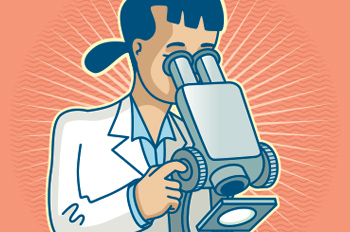
AU is deep in the planning stages for an ambitious construction project: the new life sciences building. The complex will give our 500 faculty and students the technology, tools, space, and flexibility to tackle the most pressing challenges facing our city, country, and planet. The building will foster interdisciplinary collaboration and enable faculty to undertake the groundbreaking research that our current facilities can't always support. An excellent university must have strong science programs. We do—and with your support, we can give our faculty and students the space to generate new ideas, methods, and discoveries.
Groundbreaking science
Colin Saldanha wants to find ways to regenerate the human brain. Our brains heal extremely slowly after sustaining significant injury; bird brains actually have an easier time repairing themselves following a traumatic event.
"Once something dies in the human brain it's extraordinarily difficult for it to come back, which is one reason why it's so difficult to recover from a stroke if a certain amount of damage has been done, and perhaps why degenerative brain disease is degenerative. We just don't regrow our brains that well," says Saldanha, chair of AU's biology department. "The animals I study have no problem doing so. Understanding how they do would be helpful toward developing therapies that help us to regenerate our brains."
Saldanha is one of several world-class science faculty members recruited by the university to help build AU's interdisciplinary neuroscience program. This undertaking is part of the AU 2030 initiative, a strategic planning effort that identifies groundbreaking areas for which AU can be nationally and internationally recognized. It highlights behavioral and cognitive neuroscience as one of those areas.
Saldanha's research focuses on how estrogens are delivered to specific targets in the brain, and how they help regulate plastic processes such as memory. It has implications for Alzheimer's disease (from which 5.4 million Americans suffer) and other neurodegenerative diseases that involve learning.
AU has already invested in the sciences in the form of the new Don Myers Technology and Innovation Building, which will house the computer science, physics, and mathematics and statistics departments; the AU Game Lab; and the Kogod School of Business Entrepreneurship Incubator. The university is deep in the planning stages for a new life sciences building that would boast faculty labs, offices, and classrooms, and enable AU scientists to conduct experiments they can't currently undertake.
"The building is designed by faculty to be optimal for collaborations and flexibility," says U. J. Sofia, the College of Arts and Sciences' associate dean of research. "The new building will have lab suites where multiple faculty are in the same room working at lab benches that are adjacent to each other. This leads to cross-pollination of ideas among faculty and students. We expect the students working in these labs to also benefit greatly from interactions with faculty other than their own research mentor, and with students from other research groups."
The project is vital not just for the future of AU, but for the good of the entire planet.
"Our global problems are not going to be solved by one individual field; they demand interdisciplinary approaches," Saldanha says. "The problems that we're going to be dealing with as a people for the next 200 years are scientific. Climate change is less a lawyer's domain. Antibiotic resistance is not strictly a business school question. We need to prepare our students to understand the science behind the policies that we are going to have to put into place."
For information on how you can support big ideas happening in the sciences at AU, contact Elizabeth Harless, assistant dean of development, at 202-885-5907 or harless@american.edu.
Chasing a Cure
Nicole Bonan's interest in highly metastatic squamous cell carcinoma (SCC)—a type of skin cancer that affects a disproportionately large number of organ transplant patients—isn't just academic. It's personal.
Bonan's mother, Pat, was diagnosed with a rare form of SCC in 2008. (Bonan's father is also a cancer survivor.) By the time she was in eighth grade, the Potomac, Maryland, resident knew she wanted to "help people with cancer beat the disease more quickly and less painfully."
"Whether I can actually help to find a cure or just find what doesn't work, I hope my results will help to advance the field of cancer research," Bonan, CAS/BS '16, says.
In 2014 Bonan was awarded the Gloria A. Likins Scholarship, established in 2008 by the estate of Likins, CAS/BA '60, to support undergrads—preferably women—majoring in biology or chemistry. For the last two years, Bonan worked alongside her mentor and confidante, Professor Katie DeCicco-Skinner, studying drugs that inhibit c-Met, a receptor that exists on the surface of skin cells and is associated with cell proliferation
and invasion.
"The problem we're working on is very complex and you can attack it in lots of ways," Bonan says. "It involves research, creative thinking, and lots of logical next steps."
Bonan graduated in May with a degree in biochemistry—but she's not done with AU just yet. She's pursuing a master's in biology and will be spending her summer in DeCicco-Skinner's lab.
When you're working on serious real-world problems, there's no time for vacation.